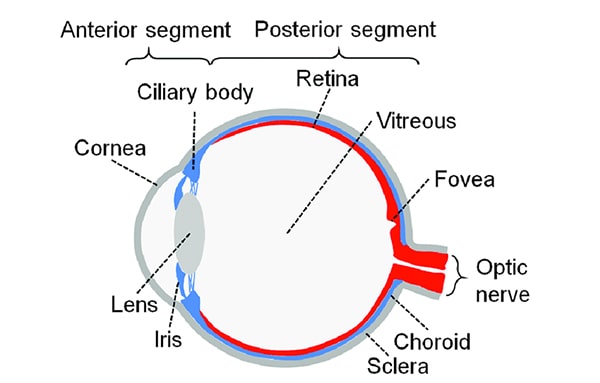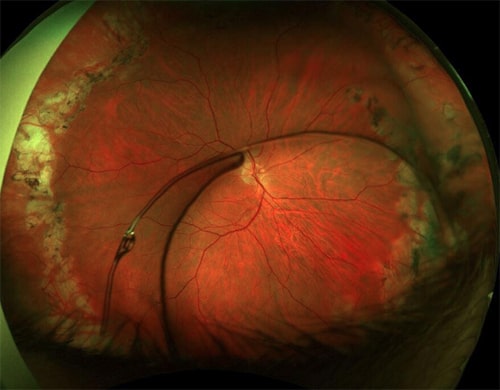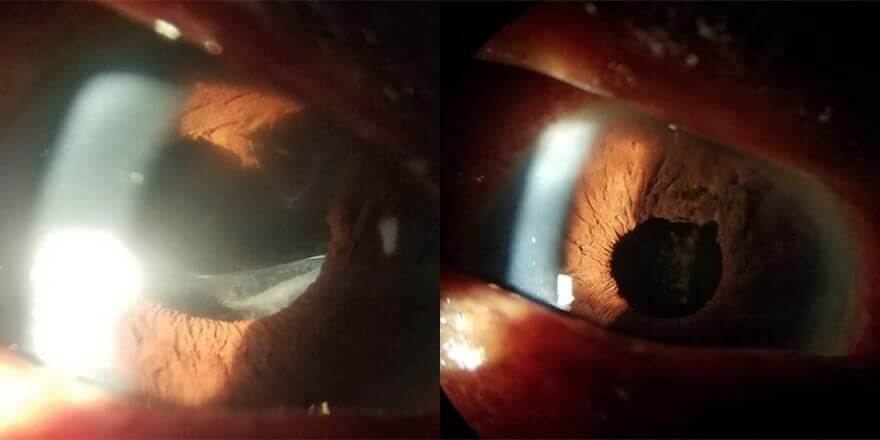Complex Anterior Segment Disease
Most disorders of the front of the eye (the anterior segment) are treated by general eye doctors (optometrists and ophthalmologists), cornea specialists, and glaucoma specialists. Occasionally, these diseases intersect with problems in the back of the eye (the posterior segment) where retina specialists focus their care. In surgical cases where complications related to cataract surgery, trauma, or inherited eye conditions have occurred, an integrated approach to treating the entire eye is needed.
The components of the human eye are very similar to those of a modern camera. In the front of the eye, the cornea and lens focuses light entering the eye onto the retina much like the lens on a camera focuses light on the film or digital sensor to create an image. The aperture of a camera controls how much light enters the camera in the same way the iris controls the size of the pupil. Disruption, disease, or damage to any of these critical elements can result in a blurred image or vision.

Typically, retina surgeons limit their care to the back of the eye (the posterior segment) while general eye doctors (optometrists and ophthalmologists), cornea specialists, and glaucoma specialists focus on the front of the eye (the anterior segment). In some circumstances, a complete and integrated approach is needed to treat issues present in both the anterior and posterior segments of the eye.
Causes & Symptoms

Immediate or delayed complications related to cataract surgery, trauma, and inherited eye conditions (Marfan syndrome, Pseudoexfoliation syndrome, and others) can lead to complex anterior segment disease. Nearly every portion of the eye can be affected or damaged by these conditions, including the cornea, iris, cataract or intraocular lens, and the retina. Depending on the cause, this can lead to blurred vision, inflammation within the eye, severe floaters, glare, and light sensitivity.
Treatment
When it comes to complex anterior segment disease, every case is different. Some patients with a history of eye trauma and damage to their lens or cornea can function well with a contact lens or glasses while others might need multiple procedures or surgeries to attain the best visual outcome possible. In general, a conservative approach is recommended before surgery is considered.
When surgery is required, your eye doctor will let you know if a retinal specialist is needed. The types of procedures we perform include vitrectomy (removal of the vitreous), repositioning, removal or exchange of dislocated or damaged intraocular lenses, pars plana lensectomy (removal of lens fragments left behind after cataract surgery), and iris repairs. In especially complex cases, our physicians will collaborate with other eye specialists to plan and perform surgery as one team.

This patient moved significantly during cataract surgery and had significant damage to his iris with fragments of his cataract falling to the back of the eye before being referred to Colorado Retina (left). After surgical treatment with a vitrectomy, lensectomy (removal of cataract fragments), iris repair, and scleral fixation of an intraocular lens he fully recovered his vision and his iris anatomy was significantly improved (right).
Watch Video
Colorado Retina’s, Murtaza Adam, MD discusses the challenges of vitreoretinal surgeries involving dislocated intraocular lenses Dr. Adam shares the details of a case involving a dislocated rigid PMMA intraocular lens and how he approached this challenging case:
Surgical Risks
Risks of surgery include bleeding, infection, glaucoma, and retinal detachment. While these risks are small, they can rarely lead to blindness in the operated eye.
Post-Surgery
After surgery, eye drops are used for approximately a month, with reading, television, computer use, and light activity permitted immediately after surgery. The eye is usually healed within one month and a refraction for new eyeglasses can be performed.
Conclusion
In summary, complex anterior segment disease spans a wide range of causes, severity, and potential surgical treatments. Your eye doctor will let you know if a Colorado Retina specialist is needed to treat your condition.
Schedule a Complex Anterior Segment Disease Consultation with Colorado Retina Associates
As the premier retina practice of the Rocky Mountains, Colorado Retina Associates provides advanced diagnostic care and treatment for Complex Anterior Segment Disease. Schedule a consultation today with one of our retina specialists in the Denver, Boulder, Aurora, and Lakewood areas.

